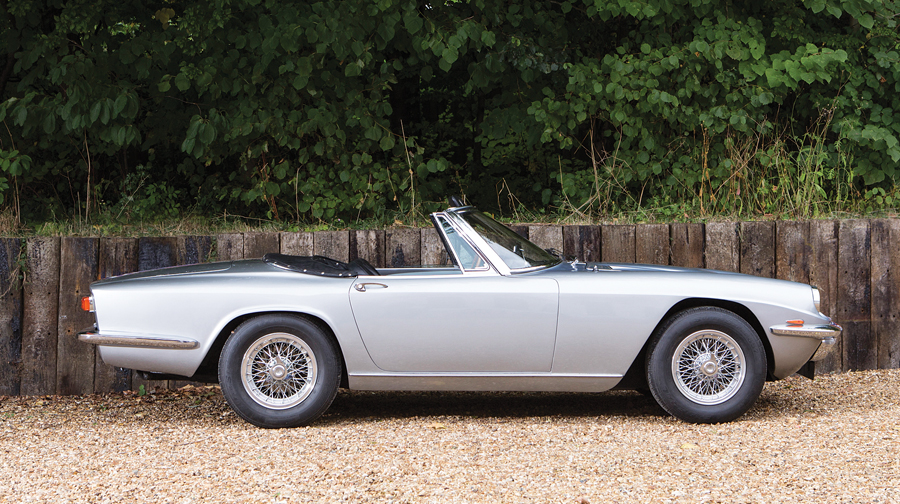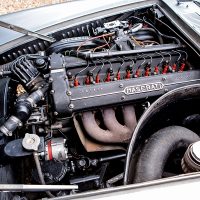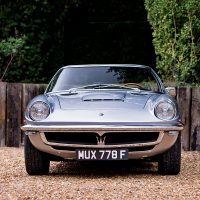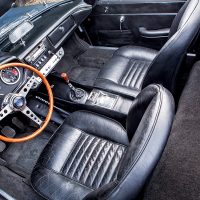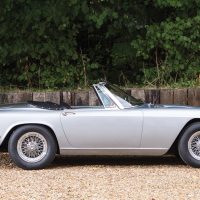SCM Analysis
Detailing
| Vehicle: | 1968 Maserati Mistral 4000 Spyder |
| Number Produced: | 37 (4.0-liter spyders) |
| Original List Price: | $13,600 |
| SCM Valuation: | $696,900 |
| Tune Up Cost: | $3,500 |
| Chassis Number Location: | Engine compartment on firewall |
| Engine Number Location: | Stamped on side of block |
| Website: | http://www.maseratinet.com |
| Alternatives: | 1968 Aston Martin DB6 Volante, 1968 AC 428 convertible, 1968 Lancia Flaminia GT convertible |
| Investment Grade: | B |
This car, Lot 20, sold for $675,358 (£535,000 £1=$1.26), including buyer’s premium, at Bonhams’ The Bond Street Sale auction in London, England, on December 4, 2016.
Following the production history of Maserati in the early 1960s can be rather confusing.
Much like the situation at Lancia, linear product marketing was not a key attribute of management. This is not, by the way, meant in any way as a criticism. We enthusiasts today can be quite thankful that “logical” standards didn’t apply — as that situation gave us an embarrassment of riches to enjoy today.
Maserati’s road car lineage
Maserati’s first road car was the A61500. A thoroughly capable machine, it nevertheless cannot be considered an exciting drive — even by the standards of the day when compared to the company’s competition machines. I still love them, and once you accept what they can do, they can deliver much satisfaction on the road. I was fortunate to drive one in the Mille Miglia Storica with a friend and client a few years ago. They don’t have nearly the power of a comparable Ferrari, but they are miles ahead in refinement.
This characteristic continued throughout the development of the Maserati GT and defined the expression of the marque. After 61 A61500 cars were built, the A6G brought more power and flexibility with a 2-liter engine, and a handful were built until real performance arrived with the DOHC A6G/54. A further 60 were made of these before Maserati’s first real production car — the 3500 GT — arrived in 1957. From introduction until 1964, almost 2,000 were built, which was a massive number, considering the history of the company. The coupes were nominal 2+2 models, and the open spyder is a 2-seater.
Enter the Mistral
The Sebring arrived in 1962, with the Mistral launched the same year as a more aggressive sporting GT. It featured a 3.7-liter DOHC 6-cylinder engine, which surprisingly produced only 10 additional horsepower. But the car’s lines were decisively more dramatic.
Carrozzeria Frua gave the Mistral flat sides, a deep windshield and delicate details, which were closely matched in the groundbreaking Quattroporte, the first 4-door luxury GT from Italy. However, the Mistral was the last of the 6-cylinder Maseratis, as the Quattroporte carried a 4.1-liter V8 and was intended as the successor to the spectacular 5000 GT at the top of the company’s offerings. The Quattroporte led the way for the V8s that would power Maseratis for decades to come.
It’s interesting to note that while a familiar face can consistently grab headlines, other lesser-known personalities are getting the job done more quietly. Ask 10 people what the most valuable open GT Maseratis might be, and most would quickly reply “Ghibli SS.” While they would be correct, what’s really interesting is that there is a very small difference between the prices of the Ghibli spyder and those of the 3500GT spyder and of our subject, the Mistral spyder.
A market mover
Five or so years back, the best-in-the-world 4-liter Mistral spyder might be found for just under $300,000. Today, that same car, spectacularly preserved or expertly restored and ready to score top honors at the international concours level, would be nearer to $800,000.
During the same period, the much-better-known Ghibli spyder, in market-ultimate 4.9L SS form, went from about $350,000 to just under $900,000. Slotting neatly in the middle is the 3500 spyder, having moved from about $275,000 to about $875,000.
And during that time, the prices have remained fairly relative to each other throughout, but the Ghibli drew the headlines, as they more often changed hands at public auction.
Right now, you can choose your Maserati spyder based on the aesthetic and driving experience rather than price. While the 3500 certainly ushered Maserati into the realm of volume production, it still has the feel of the A6G 2000, which is to say a truly marvelous, very 1950s expression of Italian motoring. It is alive and direct in a way Maseratis would never again be — yet it is also solid.
The Mistral feels much smoother, as it is more the fast boulevardier than the sister of a race car — it had been two years since the company went racing.
The Ghibli delivers tremendous performance in a thoroughly Yankee V8 fashion. All the power you need is under your right foot, but it delivers it in a totally unhurried and unfussy way. If you want to slowly cruise around town, no problem. If you want to leave all the traffic behind in your mirrors, just ask.
Maserati spyders come into their own
Our subject car offers an interesting observation of the market. From the photos and description, it’s clearly not a concours example, as the car shows clear evidence of aging, use and wear under the hood — and some small panel and trim fit issues. However, the provenance, as stated, is excellent, and the car has covered very low mileage from new. It even retains the Lucas fuel injection. Once despised, the Lucas system can be made to work quite well, as the parts to maintain the proper vacuum and metering are now available.
Depending on your driving preferences, any of the Maserati spyders would make a delightful companion on the road. And, with collectors seeking to actually use their cars today, it’s vital that usability be the determination of purchase. Many have long called these cars undervalued. I think their time has come — and not a moment too soon. I hope this car is now driven as it deserves to be. ♦
(Introductory description courtesy of Bonhams.)
